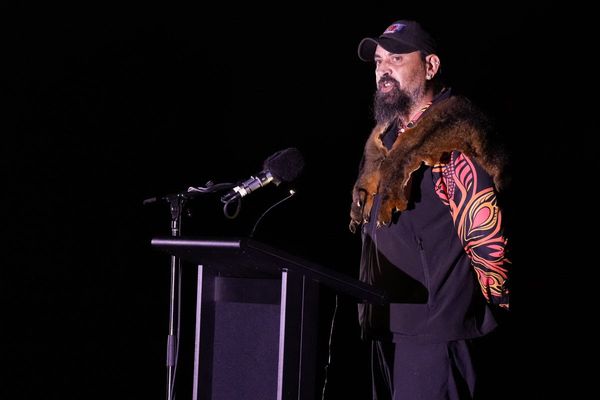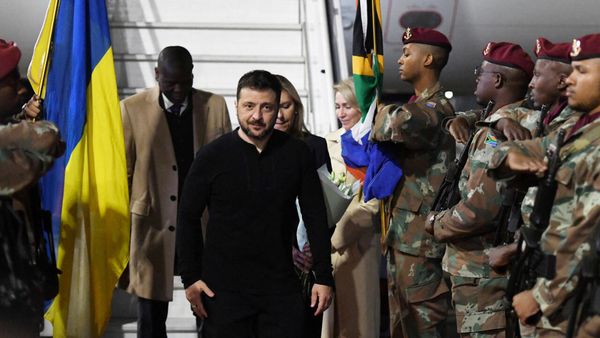
A couple from country New South Wales used the intellectually disabled teenager Amber Michelle Haigh as a “surrogate mother” so they could have another baby, before they killed her, a court has heard.
Robert and Anne Geeves, now of Harden, face one count each of murder over the suspected killing of Haigh, who disappeared without trace in June of 2002. On the opening day of the trial, the court heard how the couple had deliberately tried to “plant the seed” Haigh was suicidal, and they had set out to have her “removed from the equation”.
Haigh’s disappearance has been a high-profile public mystery in the Harden area of the Riverina, where she was living at the time.
Robert and Anne Geeves spoke in court on Friday morning only to individually plead “not guilty” to murder.
The court heard on Friday morning Haigh was an intellectually disabled teenager from Sydney who had endured a “dysfunctional upbringing” and who had moved to the Kingsvale area to live with her great aunt in the late 1990s. That aunt lived next door to the Geeves’ then property, Huntleigh, and Haigh later moved in with the Geeves.
A sexual relationship commenced between Robert Geeves and Haigh and she gave birth to a son – fathered by Geeves – in January 2002, the court heard.
Haigh disappeared sometime in June 2002. The Geeves say they drove her to Campbelltown railway station, from where she was to visit her sick father, on the evening of 5 June, and had never seen nor heard from her since, the court heard. They told police Haigh left her five-month-old son in their custody.
The Geeves reported Haigh missing on 19 June 2002. A coroner ruled she had died from “homicide or misadventure” sometime in 2002. Her body has never been found.
Paul Kerr, for the prosecution, alleged that the Geeves planned to take Haigh’s son from her and have her “removed from the equation”.
“The crown case theory is that it was always the intention of the Geeves to assume the custody and care of [the child] from Amber, but they knew that to do that, Amber had to be removed from the equation, because the Geeves knew that Amber would never voluntarily relinquish custody of [her child] and certainly not to them.
“When it became apparent that choosing their desired outcome would be more difficult than they first thought, the Geeves realised that a more fundamental, more fundamental action was needed. So, the crown asserts, they killed her.”
Kerr told the court the Geeves had had one child together – a son of almost identical age to Haigh - but the couple wanted more, having subsequently endured three miscarriages and a stillbirth.
He said the trial would hear from community members in and around Kingsvale, a small town about 120km north-west of Canberra, who were concerned Haigh was being exploited and used as a surrogate mother.
Kerr said the couple had sought to undermine Haigh’s capability as a mother, to social workers, and deliberately tried to “plant the seed” that she was suicidal.
“If this was accepted as being possible, that might deflect any suspicion that the Geeves were involved in Amber’s later disappearance or her death.”
The crown case, Kerr conceded, was “largely if not completely circumstantial in nature”.
But he said the crown argument was a “strands in the cable” case of individual threads of evidence that, collectively, “will prove beyond reasonable doubt that: one, Amber Haigh is dead; two, that Robert Geeves and Anne Geeves are criminally responsible as participants in a joint criminal enterprise to murder Amber Haigh; and three, as a result of a voluntarily and intentional act by Robert Geeves and Anne Geeves, Amber Haigh’s life was brought to an end”.
Lawyers for Robert and Anne Geeves said the case against the couple – now more than two decades old – was deeply flawed.
Michael King, acting for Anne Geeves, said his client had “no motive to kill Amber, or even wish her dead”.
She did not kill Haigh and nor did she stand by as her husband killed her, King said, and to her knowledge “Robert Geeves did not kill her”.
King said locals – who disapproved of the Geeves’ relationship with Haigh – were “all too quick to point the finger” at the couple when she disappeared.
“Everything they did was viewed through a haze of mistrust and suspicion,” he told the court.
Paul Coady, for Robert Geeves, told the court his client had “denied being in any way involved in her disappearance or murder”. He said “community distaste” at Robert Geeves’s relationship with “a much younger woman with intellectual disabilities” fuelled “gossip and innuendo”.
“Many witnesses harboured grievances or suspicions particularly against Mr Geeves.”
The court heard the crown case will include evidence of phone intercepts – placed in the Geeves’ home and car while they were being interviewed by police in 2002 – that were retranscribed in 2019, with significant discrepancies discovered in the transcripts.
The original investigating officers missed entire conversations, the court heard. The new transcripts will be contested at this trial, defence counsel said.
Amber Haigh’s mother, Rosalind Wright, told the court on Friday afternoon her daughter had moved between extended family members as a child, escaping the violence of her alcoholic father (who is now deceased).
Wright described Haigh as “bubbly” and “kindhearted” but said she had struggled at school because “it took her longer to learn things.”
She said her daughter could be “very easily misled”.
“She wasn’t a leader, she was a follower,” she said.
Wright said she had believed her daughter was in a relationship with Geeves’s teenaged son, and did not know the older man was the father of Haigh’s child until after Haigh disappeared.
Wright said the last time she saw her daughter was in November 2000 - 18 months before she disappeared - and she did not know she was pregnant until just before she gave birth.
Justice Julia Lonergan is hearing this trial judge-alone – that is, without a jury – in the NSW Supreme Court in Wagga Wagga. The trial is expected to run for several weeks.







